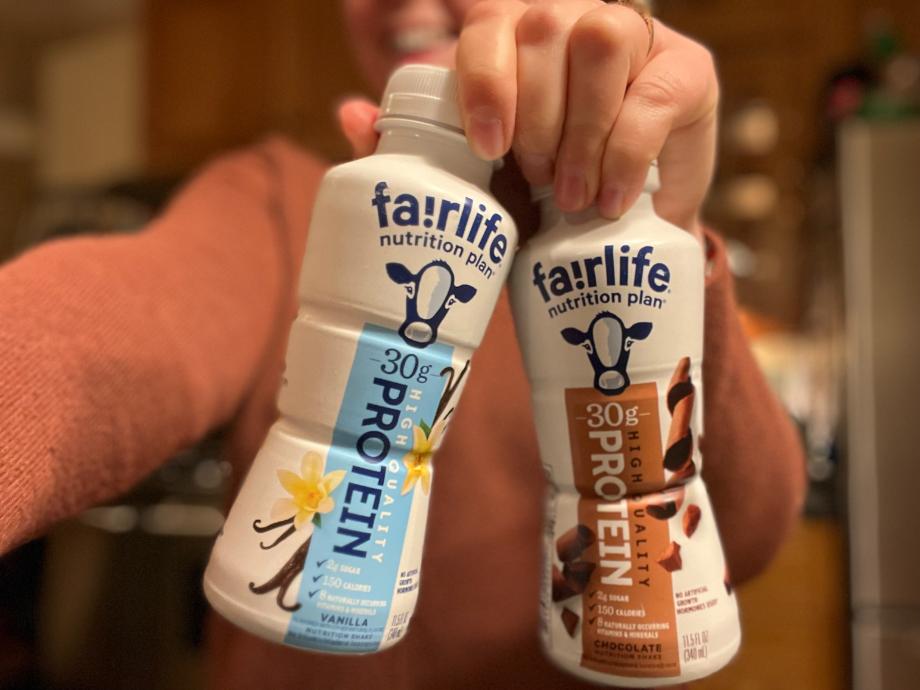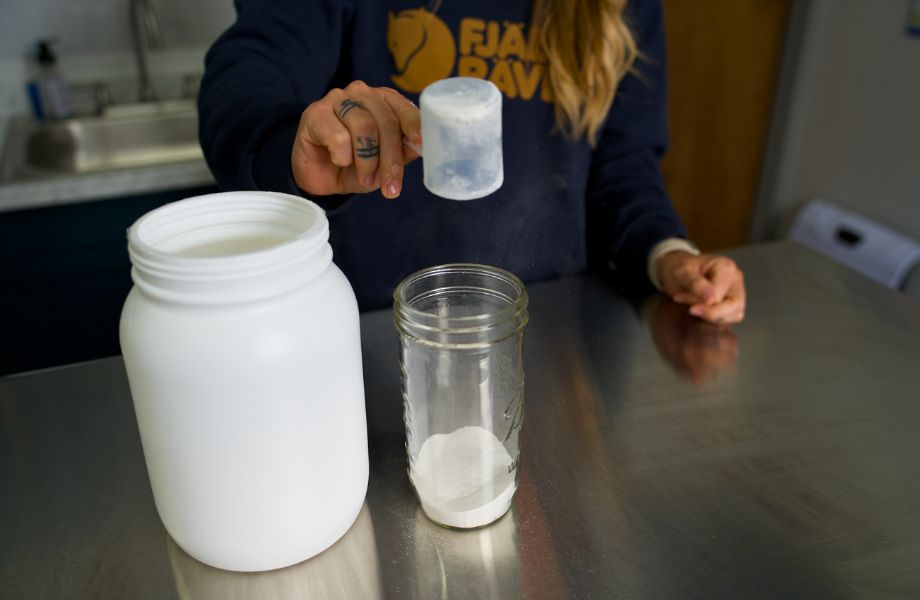You may be familiar with Garage Gym Reviews for our expert knowledge on all things fitness-related. But, we not only test and review the best home gym equipment and dietary supplements, we offer a wealth of knowledge about the fitness industry at large. This guide is a deep dive into the current protein supplements industry market size.
The global protein supplement market size is a reflection of consumers’ growing interest in health and wellness. It also includes a recent emphasis on the importance of proper protein intake. While the way people use and need protein supplements is quite broad, the growing market is creating more suitable options for a more diverse audience (like protein drinks for seniors).
This overview explores the protein supplement industry and its growth, primarily in the global market, but also looks at different regions worldwide. We’ll break down the market size by regions, countries, markets, trends, and sources to see how consumer interest and demands impact the market as a whole.
This exploration provides a closer look at the protein supplement market and where it’s heading in the coming years. If all this discussion of protein is making you hungry, go check out our best protein powder roundup and come back to get nerdy with us.
What is the Global Protein Supplement Market Size?
The global protein supplement market size is estimated to be at $19.9 billion as of 2023.
As consumers learn more about health, wellness, and nutrition, the use of supplements overall has increased. We found the global dietary market size to be roughly $182.6 billion in 2023. Some other influences on the protein market growth include:
- The rise of the fitness industry from social media and influencers has caused the demand for protein supplements to rise.
- A shift in consumer preferences, as plant based protein sources continue to grow in an effort to be more sustainable.
- As the population grows more health conscious, people are looking to help aid in their muscle recovery and muscle growth.

Key Protein Supplement Industry Market Statistics
The protein supplement market has been on the rise for years and with the growing popularity of high-protein diets and consumers’ rising interest in health and wellness, it’s on track for continued growth. Here are some quick highlights from our research:
- The protein supplement market has risen, and is projected to continue its growth as consumers become more health and nutrition conscious, along with the growing variety of products available.
- Vegan protein supplements are becoming more and more popular as plant-based protein has seen a 3355% growth with consumers over the past decade.
- North America has the largest share of the protein market, with 46% in 2023.
Annual Growth Trends in the Protein Supplement Market
This next section looks at the yearly trends of growth and growth rates for the protein supplement market.
Protein Supplement Market Size Per Year
The global market size has grown over $10 billion in the past five years, from $10.2 billion in 2019 to a projected $21.3 billion in 2024. We would be remiss not to mention that the COVID-19 pandemic was a major influence on the growing health and wellness trends including both home gym equipment and supplementation.
The chart below further breaks down each year’s annual growth.
| Year | Global Protein Market Size (in Billions $) | Global Market Growth Rate (%) |
| 2019 | $10.2 billion | 14.6% |
| 2020 | $11.6 billion | 13.70% |
| 2021 | $13.0 billion | 12% |
| 2022 | $16.8 billion | 29.10% |
| 2023 | $19.9 billion | 18.40% |
Projected Growth Rate of the Protein Supplement Market
With an estimated market size of $19.9 billion in 2023, continued growth is expected for years to come. The protein supplement market is pacing to reach over $35 billion by 2030, with a compound annual growth rate (CAGR) of 8.3% from 2023 to 2030.
To provide a clearer picture of the market size and its projected growth, the following table outlines specific figures, the estimated market size, and each year’s projected growth rate:
| Year | Global Supplement Market Size (USD Billion) | Projected Growth Rate |
| 2023 | $19.9 billion | 18.40% annually |
| 2024 | $21.28 billion | 6.90% annually |
| 2025 | $23.14 billion | 8.70% annually |
| 2026 | $25.22 billion | 8.90% annually |
| 2027 | $27.32 billion | 8.30% annually |
| 2028 | $30.06 billion | 10.10% annually |
| 2029 | $32.34 billion | 7.60% annually |
| 2030 | $37.77 billion | 16.80% annually |
Regional Distribution of Market Size and Share
Access is becoming easier, which can lead the regional distribution to shift over time. The table below shows the global market size and share of each region in 2023:
| Region | Market Size (USD Billions) | Market Share |
| North America | $9.2 | 46% |
| Asia-Pacific | $4.1 | 21% |
| Europe | $4.3 | 22% |
| Middle East & Africa | $1.1 | 5.53% |
| Latin America | $1.2 | 6.0% |
Looking at the graph above, we can see:
- North America has 46% of the market share, with a total market size of $9.2 billion.
- Although the Asia-Pacific region has only 21% of the market share in 2023, the region is projected to grow the fastest from 2023 to 2030 at a CAGR of just under 9%.
- Overall, key drivers include a greater awareness of the benefits of protein supplements globally to consumers as well as easier access to these supplements.
Country-Specific Protein Supplement Market Trends
Below is a look at some of the top countries in the protein supplement industry, based on market size, as well as the projected CAGR over the next five years.
| Country | Market Size (USD) | CAGR (2023-2028) |
| US | $8.1 B | 7.6% |
| China | $2.2 B | 7.1% |
| Japan | $520 M | 2.1% |
| Germany | $730.8 M | 4.3% |
Key Types of Protein Supplements
Out of the main sources of protein supplements, animal-based proteins are still dominating the market and hold a market share of over 60%.
- Plant-based sources are set to grow the fastest from 2023 to 2030 at a CAGR just under 9%.
- Whey-based protein supplements are most popular and claim over 50% of the market.
- With the increase in plant-based diets and preferences, soy-based protein supplements claim the second highest market share behind whey.
- In the US alone, 67% of people tried to consume more protein in 2023.
The chart below breaks down each category’s market share and size.
| Category | Market Share | Sales (USD Billions) |
| Whey | 53.47% | $10.86 |
| Casein | 11.32% | $2.30 |
| Egg | 5.91% | $1.20 |
| Soy | 21.91% | $4.45 |
| Pea | 7.39% | $1.50 |
Popular Forms of Protein Supplements
Below is a look at the market based on the form in which the supplement is consumed: powder, ready-to-drink products, and protein bars.
| Form | Market Share | Market Size (USD Billions) |
| Powder | 67.69% | $13.2 |
| Ready to drink | 8.21% | $1.6 |
| Bars | 24.10% | $4.7 |
- Powders lead the global market for the most popular form of protein supplements. With the variety of options available and numerous distributors, these supplements are becoming more affordable for consumers.
- Ready-to-drink products are becoming more popular with consumers due to the ease of consumption and convenience. This segment is expected to see increased growth in the years to come as more products continuously come to market.
- Protein bars are expected to grow in popularity globally due to their on-the-go convenience. They’re great for folks who are always on the move but still want to keep their protein intake up.

Main Distribution Channels for Protein Supplements
When looking at the distribution channels for protein supplements, we see that:
- Offline distribution has had a massive majority of the market share with 48%, due to the popularity of supermarkets and hypermarkets. Typically, they’re convenient to get to, and having multiple brands in one place makes it easy for consumers to compare.
- Online distribution is poised to grow at a CAGR of over 8.5% from 2023 to 2030, with the growing popularity of E-Commerce and the rising trend of making health product purchases online.
Key Protein Supplements Companies
The key players in the protein supplement industry are Abbott Laboratories, BPI Sports, Transparent Labs, Now Foods, and The Bountiful Company. This market is constantly growing as new players continuously get into the protein game.
With the market becoming more competitive, R&D has become extremely important for these companies. Consumers are emphasizing high-quality products and diverse source options for their dietary needs with new and intriguing flavors. Companies must be able to adapt their products to consumer’s preferences.
Some dietary supplement companies are even creating custom supplement blends based on dietary preferences, health questionnaires, or genetic makeup. While this is still a small part of the protein supplement industry, it’s a biohacking trend we’ve seen in recent years.
RELATED: What is Biohacking?
Fair Use Statement
If you have any questions about the information mentioned above don’t hesitate to email Jonathan Weissberg, Garage Gym Reviews fitness research director at jonathan@email.garagegymreviews.com.
You are welcome to use any of the findings, data, and graphs from this report, but we ask that you provide a link back to our study to cite the original data source.
Protein Supplement Market Size Facts: FAQs
What is the current global market size of the protein supplement industry?
The current global market size of the protein supplement industry is $19.9 billion as of 2023.
How has the protein supplement market grown annually on a global scale?
The protein supplement market is on track to reach over $37 billion by 2030, growing at a compound annual growth rate (CAGR) of 8.3% from 2023 to 2030.
What are the leading protein sources contributing to the supplement market’s growth?
Major contributors to the protein supplement market’s size and growth are whey-based and soy-based supplements, which claim 53.47% and 21.91% of the global market share, respectively.
Which region is witnessing the fastest growth in the supplement market?
The Asia-Pacific region is projected to grow the fastest from 2023 to 2030 at a compound annual growth rate (CAGR) of just under 9%.
How do online distribution channels impact the protein supplement market?
Online distribution is set to grow at a compound annual growth rate (CAGR) over 8.5% from 2023 to 2030 with the growing popularity and convenience of E-Commerce, and the fast-paced consumer lifestyle.






